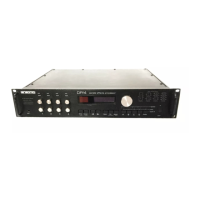Section 2 — Algorithms
ENSONIQ DP/4+ Reference Manual 79
06 — Trigger Threshold Range: -96 to +00 dB
Set this parameter as low as possible to work with your particular sound source. To eliminate
false triggering, it should not be set too low. When the input signal rises above this threshold, the
reverse envelope will begin.
07 — HF Damping Range: 00 to 99
This parameter sounds best when it’s set to low values. It has the same function as in the Plate
Reverb, which is to filter out more and more high frequency energy. For the most natural
sounding reverse effect, we recommend a setting of 00.
08 — Diffusion 1 Range: 00 to 99
Diffusion 1 smears the input signal making a smoother sounding reverb. This parameter controls
the high frequency ranges. For percussion sounds, high values are recommended.
09 — Diffusion 2 Range: 00 to 99
Similar to and in series with Diffusion 1, this parameter controls lower frequency ranges.
10 — Decay Definition Range: 00 to 99
Controls the rate at which echo density is increased with time. If set too high, the echo density
will build at a rate that exceeds the decay rate. This can be used for a special effect.
11 — Slapback Range: 0 to 530ms
Controls the delay time of an internal dry signal to create a slapback. This effect helps to simulate
a backwards reverb, since now the dry signal appears at the end. In general, we recommend the
Mix (parameter 01) be set all wet (99) for this effect. Rule of thumb: Set this parameter at about
the same value as the Envelope Hold Time (parameter 03).
12 — Slapback Level Range: 00 to 99
Adjusts the volume of the slapback (internal dry) signal. A value of 00 would eliminate audible
slapback.
13 — Mod1 Source 17 — Mod2 Source
14 — Mod1 Destination 18 — Mod2 Destination
15 — Mod1 Param Range Min 19 — Mod2 Param Range Min
16 — Mod1 Param Range Max20 — Mod2 Param Range Max
See the descriptions under the Algorithm Modulators, in the beginning of this section.

